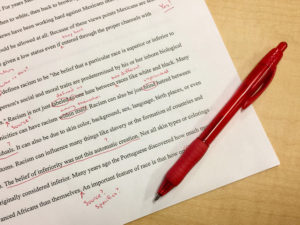Why You Should Rarely Use Jargon in Your Fundraising
Don’t Let the Jargonasaur Scare Away Your Donors
Maybe it’s my background in education, but I can’t stand jargon. I’ll never forget reading about the school board candidates in my voter’s pamphlet one year. One of their descriptions was so packed with industry jargon, buzzwords, and clichés, I felt like I was back in college.
What fun it was when I discovered that this particular candidate has a PhD in education research. So smart that no one knows what she’s talking about.
You may love research and get butterflies when reading or writing PhD-speak, but your donors hate it.
A recent Crazy Egg article – written for a business audience – tears to shreds the overuse of jargon in marketing.
Here are five reasons nonprofits and businesses justify their use of jargon, also known as industry- or company-specific language.
5 Reasons Nonprofits Use Jargon in Fundraising
1. They Think Jargon Sounds More Professional
The truth is, jargon just makes your nonprofit seem unapproachable. If you come down on people for not knowing specialized terms associated with your mission, you’re only going to make them feel like an outsider. “This isn’t my club,” is what it feels like to be caught in the jaws of the jargonasaur.
I liken it to hanging out with a room full of techies. Ever done that? They can sit there for hours and just go on and on about coding and devices and apps and all the tech that’s behind them. I get bored in ten minutes, barely understand anything they’re saying, and honestly, just don’t care.
That’s how it feels to read a fundraising letter chock full of jargon. It drives people away. It puts a barrier between them and you. And a barrier is the last thing you want if you’re hoping someone gives you money.
You actually can use impressive language in fundraising, but jargon is the wrong way to do it. Instead of investing time in jargon, invest it in your verbs. That’s a better way to connect with an audience.
Get 4 copywriting tips on using verbs in fundraising
2. Competitors Are Using Jargon, So We Should Too
If your competitors jumped off a cliff, would you follow them? Sorry for the teenager/parenting reference… but especially in the nonprofit world, many organizations are not using ‘best practices’ (that’s one of those jargon words I can’t stand…and I’m using it!!).
Nonprofit websites and fundraising appeals often diverge from what has proven by data to be the more effective strategies at our disposal. Future Fundraising Now’s ‘Stupid Nonprofit Ads’ highlights some of this divergence.
So just because they’re doing it doesn’t mean you should.
If you read their website and feel informed by all the ‘substance’ and ‘depth’ of language, there’s a good chance hardly any of their donors read it.
In other words, know your audience. Most of your donors are not researchers. Most are not experts in your field. They just care about solving a problem that your nonprofit is trying to solve.
Help them solve it. Don’t make them feel like they’re taking the SAT again.
3. Hard to Separate What You Do from Jargon
Yes, you can. In almost every situation, you can find a better, clearer, simpler way to say something so a mass audience will stay engaged and keep tracking with you.
This does not make your nonprofit sound simplistic. It makes you sound real.
Take a phrase like ‘environmental degradation.’ Sure, a news reporter might use it. A researcher definitely would. But the average person on the street who just wants a cleaner world? Instead of helping ease environmental degradation, we’re helping fix the planet.
Say that then.
In those rare instances where jargon actually does best express an idea you want your donors to act on, then you need to clarify for them the meaning and importance of that term. The example that comes to mind, because I subscribe to their newsletter, is Equality Now’s the use of the term FGM.
This is an acronym AND an industry-specific term. The jargonasaur LOVES acronyms because they make great snacks, and even fewer people understand them. Normally, I’d go running through the streets to avoid using terms like this.
But in this instance, FGM is the term that best describes the idea. The term itself – especially the non-acronym one – arouses emotion in the reader simply because of how terrible it is. In other words, this is a word that shouldn’t even exist. But in a world as fallen as ours, it does.
In writing a fundraising appeal, if I worked for Equality Now, I would never send something out without spelling out this term, and communicating the abuse and oppression that lies behind it.
In other words, a skilled copywriter (such as ProActive Content – ask for fundraising copywriting help for your nonprofit) knows how to frame the jargon word and give life to it. If the term matters so much that you must use it, then make it matter to your audience. Don’t just start using it and assume everyone knows what it means.
In their email newsletter on this topic, Future Fundraising Now added a few other reasons nonprofits might justify using jargon. Here’s their most pertinent one:
4. You Value Technical Accuracy over Clarity

Image by Anne Karakash from Pixabay
I can always tell when my copywriting is being edited by an English major or a journalist. They break up my contractions, criticize me for starting sentences with ‘and’ and ‘but,’ and combine all the little paragraphs into big massive (and harder to read) ones.
And they nearly retch at my sentence fragments.
But, if you put my writing next to theirs and gave it to a random group of 100 people, I can pretty much guarantee whose writing most people would get through first and understand faster.
Technical accuracy is like that.
It slows down the read. Makes it harder to understand. Clouds the purpose. And weakens the call to action.
Technical accuracy is just not nearly as important as some people think it is. And the longer you’ve worked for an organization, the harder it is to remain sensitive to the perspectives of your donors who don’t know nearly as much as you.
When I was a high school teacher of chemistry, this became harder and harder each year because my knowledge of the content deepened every year I taught it. But my students each September came in knowing the exact same thing about chemistry. Which was nothing, in most cases. By the end of the year, they knew a whole lot more, and it felt great. But then September came again…
That’s somewhat how it feels to work at a nonprofit for a long time. You can easily forget how little your potential donors know about whatever area of need your nonprofit serves.
Am I saying to be inaccurate? No. But the chemistry teaching analogy applies here too. Did you know that some portions of what we teach in high school chemistry isn’t actually accurate (like that oversimplified drawing of an atom)? Yes, we’re teaching them stuff that’s not correct. Isn’t that just awful?
Well, no. Because the full complexity of the truth is simply too much for someone to understand in their first exposure to chemistry. They must first understand core concepts and ideas before they can start exploring the true reality.
In the same way, you don’t need to be 100% accurate in your fundraising language.
Suppose your charity has a vocational training program.
Technical accuracy might say to describe every element of that program, and be clear about what happens at the halfway point, when some students graduate to one branch while the rest get moved to a different one. And emphasize what constitutes graduation. And stress the importance of the internship portion, and how you find companies to work with. And don’t forget all the special relationships you’ve forged with those businesses.
No.
You help people without jobs gain the skills they need to get good jobs that will provide for their families.
That’s it. That’s what you do.
Don’t overcomplicate it.
5. Just Don’t Realize You’re Doing It

Image by OpenClipart-Vectors from Pixabay
Lastly, I’d add this one to the list of reasons nonprofits use jargon. They just don’t realize they’re doing it.
Again, this usually happens because the people writing your fundraising and other content have often been steeped in your mission and communications for a while.
The simplest solution to this is to reach out to an independent fundraising copywriter who will see your mission in the same way prospective donors do – from the outside.
My first question when interacting with a new nonprofit is, “What do you do?” In other words, what is your mission? And there are so many terrific missions being accomplished across the nonprofit world.
Let’s let people be part of those missions by making it easy for them to answer that question and the most important follow-up one: “How can I help?”
Need Fundraising Copywriting Help from a New Voice?
Reach out to ProActive Content and get a free 60-minute conversation to discuss your situation with a fundraising copywriter.
Want more content? Get weekly nonprofit fundraising and copywriting tips, strategies, and motivations in the ProActive Insights newsletter.




